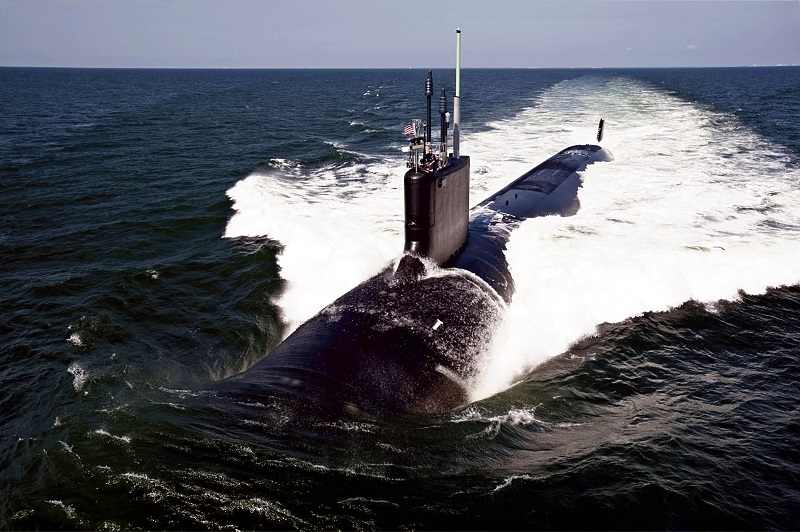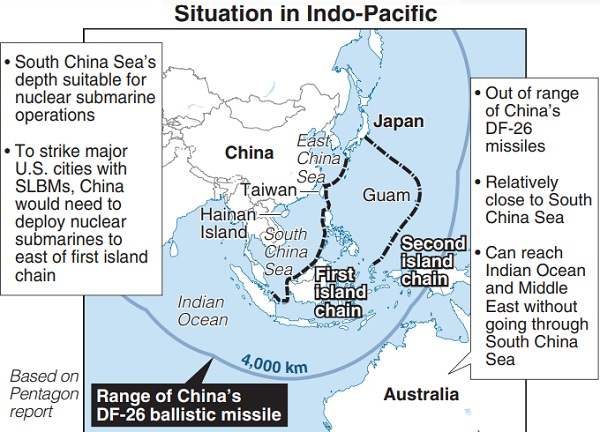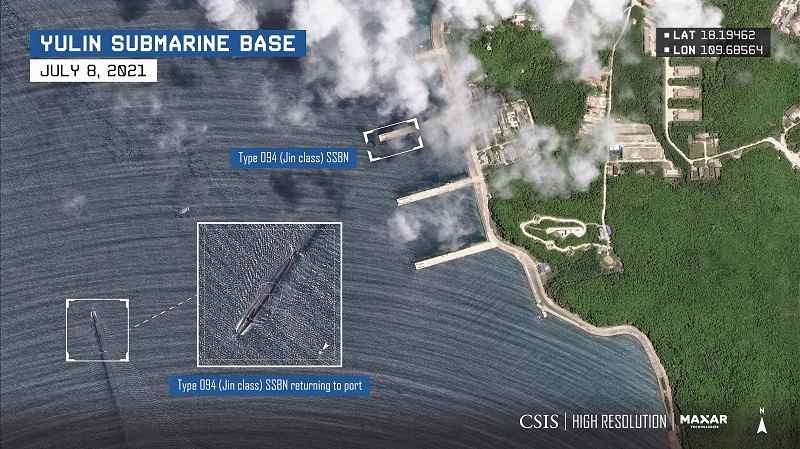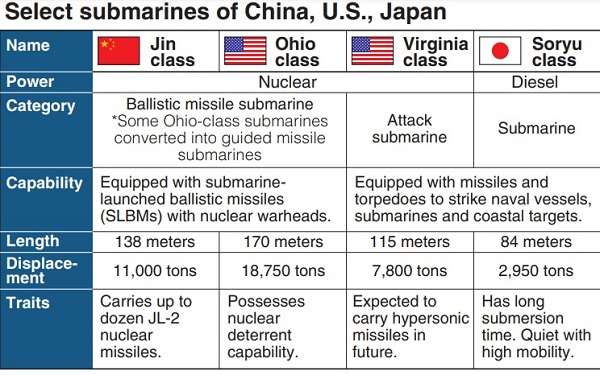
An image of a U.S. Navy Virginia-class nuclear-powered attack submarine, the type Australia wants to introduce into its fleet.
16:01 JST, October 12, 2021
WASHINGTON — A key component of the U.S. plan to counter China’s growing military presence in the Indo-Pacific is to help Australia build nuclear-powered submarines.
U.S. President Joe Biden’s administration, together with London and Canberra, have formed a trilateral security framework dubbed AUKUS, with the introduction of nuclear submarines into Australia’s arsenal as the centerpiece.
Amid China’s continuing actions to tilt the military balance in the Indo-Pacific, how did this deal come about among Australia, the United Kingdom and the United States?

An illustration : Situation in Indo-Pacific ituation in Indo-Pacific
Fight for undersea supremacy
“This will significantly improve the Australian Navy’s reach and defensive capabilities,” U.S. Defense Secretary Lloyd Austin said after the announcement of the creation of AUKUS on Sept. 16, explaining the significance of the deployment of nuclear submarines. “It will also help to contribute to what I call integrated deterrence in the region, the ability for the United States military to work more effectively with our allies and partners in defense of our shared security interests.”
What Austin meant by “integrated deterrence” is a U.S. military strategy based on cooperation with allied and friendly nations in cutting-edge areas, such as technological innovation. In the case of AUKUS, it is with an eye to countering the Chinese military.
According to a report released by the U.S. Defense Department in September 2020, China became the world’s largest navy, with approximately 350 naval vessels, surpassing the 293 U.S. vessels.
What China is aiming for is a military strategy called “anti-access/area denial,” or A2/AD.
In the event of an incident involving Taiwan or in the South China Sea, the strategy aims to block U.S. military operations inside the western Pacific’s second island chain, which runs through the U.S. territory of Guam, while not allowing U.S. forces to enter the first island chain closer to China. This strategy can only work if China deploys a large number of naval vessels over a wide area as if creating another great wall of sorts.
To defeat this A2/AD strategy, the U.S. military is focusing on submarines. Even if the approach to the waters around China is blocked at sea or through the air, the U.S. military can deliver a devastating blow to Chinese aircraft carriers and missile launch facilities by breaking through undersea with submarines.
When it comes to submarines deployed in the undersea domain, the United States maintains its superiority over China.
In particular, the United States has a significant advantage over China in nuclear-powered submarines, which have a long range and are quieter, making them more difficult to detect from the surface.
As of 2020, the United States has 68 submarines, all nuclear-powered. According to a report by the U.S. Congress, the United States has 14 Ohio-class ballistic missile submarines, 50 attack submarines, including 19 in the state-of-the-art Virginia class, and four guided-missile submarines.
Though China possesses 66 submarines, only 11 are nuclear submarines: four ballistic missile subs and seven attack subs.
As the U.S. Navy is deployed all over the world, there are only eight to 12 nuclear submarines with the U.S. 7th Fleet, which covers the Western Pacific and Indian Oceans.
By 2030, China is expected to nearly double the number of its nuclear submarines, to 21, which means that China could by then have the advantage in the Indo-Pacific.
The United States strengthened its relationship with Australia in the AUKUS alliance because it was concerned about China’s growing sea power. In cooperation with Britain, the plan is to deploy eight Virginia-class or equivalent nuclear submarines to Australia, aiming to maintain the advantage in a future race for nuclear submarine superiority.
South China Sea route
The Chinese military is also steadily advancing its nuclear submarine strategy.
In July, a commercial satellite captured the image of a Chinese Navy’s Jin-class ballistic missile submarine moving at sea off the coast of China’s Hainan Island in the South China Sea.
The sub is believed to be capable of carrying up to 12 submarine-launched ballistic missiles (SLBMs) with nuclear warheads known as the Julang-2 (JL-2) with a range of about 8,000 kilometers.

A satellite image from July 8 captured one of China’s Jin-class ballistic missile submarines sailing near China’s naval base on Hainan Island.
According to researchers at the Center for Strategic and International Studies who analyzed the satellite images, two Jin-class subs and two Shang-class attack submarines were confirmed to be moored at China’s Hainan base in images taken on another day.
China aims to ensure that it will have multiple means to counterattack with nuclear weapons to strengthen its deterrence against the United States. China’s ballistic missile submarines provide one of the means.
To attack major U.S. cities with SLBMs, China would need to deploy nuclear submarines to the east of the first island chain. In the East China Sea, Japan and the United States maintain a strong presence with regard to surveillance, making it difficult for China to break through.
If China can gain the upper hand in the South China Sea, an area where defenses are relatively weak, it will be able to secure a route for its nuclear submarines to deploy to the Western Pacific.
Toshi Yoshihara, a senior fellow at the U.S. Center for Strategic and Budgetary Assessments who is well versed in the Chinese Navy, said China is building artificial islands in the South China Sea to create military bases in order to build strongholds so that their nuclear submarines can operate more safely.
Yoshihara predicts that China will improve the quietness of its nuclear submarines and extend the range of its SLBMs. The possibility that nuclear submarines could operate far from the Chinese mainland and directly threaten U.S. military bases such as at Guam should also be considered, he said.
Long time to introduction
Australia’s introduction of nuclear submarines comes with strong awareness of China’s strategy of expanding from such southern waters. Australia’s future nuclear submarine fleet is expected to act as a barrier in the South China Sea.
There are many hurdles, however, that must be overcome before Australian submarines are actually deployed in the region. United States, Britain and Australia are expected to draw up concrete plans over the coming 18 months.
Given that the Australian military — which does not have nuclear weapons — has not accumulated nuclear technology and will need time to train personnel, it is widely believed that any nuclear submarine will not enter service until 2035 or later.
Ashley Townshend of the United States Studies Centre at the University of Sydney predicts that because the United States does not have spare capacity to manufacture nuclear submarines, Canberra will likely conclude a treaty with Washington to receive technology for nuclear submarines, while manufacturing will proceed jointly with Britain.
Townshend also said the U.S. government is expected to resist the provision of nuclear submarine technology, which it considers a top secret of the Untied States. The biggest challenge will be whether Australia can obtain the understanding of the U.S. Congress and proceed smoothly with the provision of that technology, Townshend said.
Most powerful stealth weapon
As submarines can dive deep into the ocean and are therefore difficult to detect, they are considered the most powerful stealth weapon.
Nuclear-powered submarines can produce fresh water by distilling seawater with the heat from a nuclear reactor. They can also produce oxygen by electrolysis of water, making them capable of semi-permanent submersion.
Currently, nuclear submarines are deployed by six nations — Britain, China, France, India, Russia and the United States — that also possess nuclear weapons.
Through the AUKUS deal, Australia intends to introduce nuclear attack submarines that do not carry nuclear weapons.
Attack subs can stay submerged close to land or ships to launch attacks. They are used for a variety of purposes, including tracking enemy submarines and surface ships, supporting carrier strike groups and conducting intelligence and surveillance activities.
Conventional submarines are powered by diesel engines and rechargeable batteries. On batteries, they can operate more quietly than nuclear submarines, but they need to rise to the surface regularly to secure oxygen and to replenish water and fuel.
The submarines of the Self-Defense Forces are all conventional types, but they are known for their high performance. The most advanced Soryu-class submarines are said to have the world’s top-class performance, with strengths in quietness, cruising range and underwater sound detection. These types of subs had been in competition with France’s submarines in the bid to jointly develop submarines with Australia.

Sources: CSIS, U.S. Navy, Maritime Self-Defense Force
"World" POPULAR ARTICLE
-

8 Japanese Nationals Stranded on Indonesia’s Sumatra Island
-

U.S. Senate Resolution Backs Japan, Condemns China’s Pressure
-

China to Impose Sanctions on Shigeru Iwasaki, Former Head of Japan’s Self-Defense Forces, Who Serves as Adviser to Taiwan’s Executive Branch
-

South Korea’s Top Court Dismisses Nippon Steel Appeal in Lawsuit over Requisitioned Worker
-

75% of Myanmar People Reject Army’s Political Involvement, According to Survey Conducted by Aid Organization
JN ACCESS RANKING
-

Tokyo Economic Security Forum to Hold Inaugural Meeting Amid Tense Global Environment
-

Keidanren Chairman Yoshinobu Tsutsui Visits Kashiwazaki-Kariwa Nuclear Power Plant; Inspects New Emergency Safety System
-

Imports of Rare Earths from China Facing Delays, May Be Caused by Deterioration of Japan-China Relations
-

University of Tokyo Professor Discusses Japanese Economic Security in Interview Ahead of Forum
-

Japan Pulls out of Vietnam Nuclear Project, Complicating Hanoi’s Power Plans





















